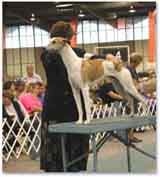Show Dog InformationTraining Your Puppy To Become Lead-Broken |
|
|
As someone who wants to raise their puppy to become a winning show dog there are several things that you should be doing while waiting for your puppy to grow up. Let's take just a little time right now and discuss how to do some of these things. Let's start with the lead-breaking of your puppy since it is so important to the attractive stylish gait of a show dog. Let's assume that when you bought him he had never been on a lead. There are many methods advocated by dog enthusiasts. Some allow the young puppy to drag a lead for a few days so he won't object to it. Some folks attach a light weight to a short lead around the puppy's neck and let him carry it around so that he will learn to hold his head up high. Some use the reward method giving the dog a tidbit if he does the job well and withholding it if he does not. Once the puppy is well lead-broken it does not matter which method was used in the training since the outcome is all we are interested in. After trying many, here is the method that averages as the best. Start training the puppy just as soon as you get him. If you keep him in a run or pen, every time you take him on a lead you should keep in mind that this will be his training period. However, if the puppy lives in the house with you and, at least in the beginning, has to be taken out on a lead to relieve himself, there should be a difference in the manner in which you and the puppy behaves while he is on the lead. Don't try to lead-break him for shows when he has other and more important business on his mind. Allow the puppy to sniff the ground and use a longer lead, giving him ample time to take care of his duties. If he is allowed to roam where he wants to and when he wants to he will scarcely be aware of the fact that he is on a lead and the duties will be taken care of quickly. With that important business out of the way you can then settle down to the training. Now tighten up on the lead. Put the collar as far forward under the dog's jaw as you can. He will resent it, perhaps fight it, some dogs jumping into the air and screaming as though they had been hurt. Wait until he quiets down and then start walking in the direction you want to go and talk to the dog. Call him by name and keep your voice pleasant. Don't drag him but keep the lead taught so he can feel in which direction he is being coaxed to go. As soon as he takes a few steps with you, praise him loudly and keep encouraging him to go along. After he goes along, try releasing the lead a bit and if he keeps going fine! If not, use short jerks to keep him going. After the puppy goes along a reasonable distance, stop and pat him, praise him to the skies. Then start out again. Repeat this performance several times and until he goes along with you without your having to tug at him.Back to the Show Dog Information page
| |
|
Related News About Dogs ' ); // get rid of newsfeed display by carp CarpConf('poweredby',''); CarpCacheShow('http://www.petfriendlyworld.com/chat/index.php?action=.xml;board=16;type=rss'); ?>
|
|
|
|
|
|
Copyright © 2006-2007 dogguidance.com |


